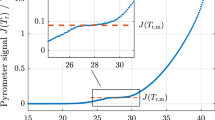Abstract
Fast resistive pulse-heating techniques and electromagnetic levitation techniques are capable of determining thermophysical properties of metals in the liquid phase. These properties have become increasingly important as input data for modern numerical simulations. Among others, density is a very relevant parameter for e.g., casting modeling. Density determinations of copper and nickel in their liquid states are performed using a fast resistive pulse-heating setup and a recently build up electromagnetic levitation apparatus. Both methods use optical imaging techniques to determine thermal expansion of the specimen under investigation, but are operating at very different experimental durations. The pulse-heating setup provides a heating of the sample using it as part of an electrical discharge circuit. Heating rates of 108 K/s lead to experimental durations of about 60 µs. Temperature is determined by measuring surface radiance emitted from the sample by a pyrometer. The sample’s thermal expansion is monitored by an adapted CCD camera system. The electromagnetic levitation apparatus enables noncontact investigations of samples by levitating and heating them by an induction coil generating inhomogeneous electromagnetic fields. Temperature again is determined by a pyrometer. For thermal expansion determination, shadowgraph images are recorded with a high-speed CCD camera and evaluated with an edge detection algorithm. Thermal expansion then is calculated by averaging several 1000 frames for each temperature point. Investigations of copper and nickel in the liquid state were performed with both techniques and are compared to each other and to literature values.





Similar content being viewed by others
References
E. Kaschnitz, G. Pottlacher, and H. Jäger: Int. J. Thermophys., 1992, vol. 13(4), pp. 699–710.
B. Wilthan, C. Cagran, and G. Pottlacher: Int. J. Thermophys., 2005, vol. 26, pp. 1017–29.
T. Hüpf, C. Cagran, G. Lohöfer, and G. Pottlacher: J. Phys./Condens. Matter, 2008, vol. 98, pp. 82–5.
M.J. Assael, A.E. Kalyva, K.D. Antoniadis, R.M. Banish, I. Egry, J. Wu, E. Kaschnitz, and W.A. Wakeham: J. Phys. Chem. Ref. Data, 2010, vol. 39(3), pp. 033105 1–8.
M.J. Assael, A.E. Kalyva, K.D. Antoniadis, R.M. Banish, I. Egry, J. Wu, E. Kaschnitz, and W.A. Wakeham: High Temp.-High Press., 2012, vol. 41, pp. 161–84.
C. Cagran, T. Hüpf, B. Wilthan, and G. Pottlacher: High Temp.-High Press., 2008, vol. 37, pp. 205–19.
C. Cagran, B. Wilthan, G. Pottlacher, B. Roebuck, M. Wickins, and R. A. Harding: Intermetallics, 2003, vol. 11, pp. 1327–34.
H. Preston-Thomas: Metrologia, 1990, vol. 27, pp. 3–10.
C. Cagran, C. Brunner, A. Seifter, and G. Pottlacher: High Temp.-High. Press., 2002, vol. 34, pp. 669–79.
T. Hüpf, C. Cagran, E. Kaschnitz, and G. Pottlacher: Thermochimica Acta, 2009, vol. 494, pp. 40–4.
T. Hüpf and G. Pottlacher: Thermal Conductivity 30—Thermal Expansion 18, 2010, D.S. Gaal, ed., ISBN No. 978-1-60595-015-0, pp. 192–206.
C. Cagran: Diploma Thesis, TU Graz, 2000.
J. Brillo and I. Egry: Int. J. Thermophys., 2003, vol. 24(4), pp. 1155–70.
G. Lohöfer, J. Brillo, and I. Egry: Int. J. Thermophys., 2004, vol. 25(5), pp. 1535–50.
K. Aziz, A. Schmon, and G. Pottlacher: High Temp.-High Press., 2014, vol. 43, pp. 193–200.
D.R. Lide: CRC Handbook of Chemistry and Physics, 88th ed., CRC Press LLC, 2007, pp. 4–20.
Acknowledgments
We are grateful for the interchange of scientific equipment between Institute of Materials Physics in Space, German Aerospace Center (DLR), Linder Höhe, 51147 Köln, Germany and Institute of Experimental Physics, Graz University of Technology, Petersgasse 16, 8010 Graz, Austria. The project Measurement of surface tension and density by means of levitation is supported by the Austrian Science Fund (FWF)—Project P 23838-N20.
Author information
Authors and Affiliations
Corresponding author
Additional information
Manuscript submitted October 21, 2014.
Rights and permissions
About this article
Cite this article
Schmon, A., Aziz, K. & Pottlacher, G. Density Determination of Liquid Copper and Liquid Nickel by Means of Fast Resistive Pulse Heating and Electromagnetic Levitation. Metall Mater Trans A 46, 2674–2679 (2015). https://doi.org/10.1007/s11661-015-2844-1
Published:
Issue Date:
DOI: https://doi.org/10.1007/s11661-015-2844-1




